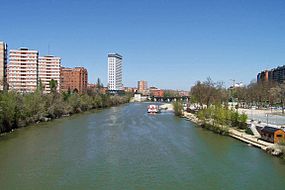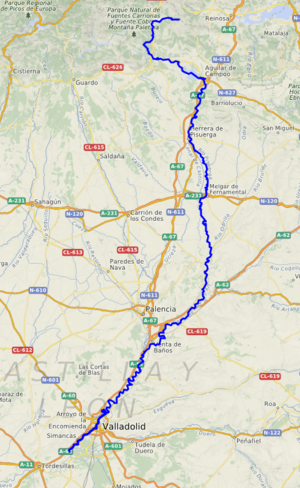Pisuerga facts for kids
Quick facts for kids Pisuerga |
|
|---|---|

The Pisuerga passing through Valladolid.
|
|
 |
|
| Country | Spain |
| Region | |
| Physical characteristics | |
| Main source | Cantabrian Mountains 1,800 m (5,900 ft) |
| River mouth | 678 m (2,224 ft) |
| Length | 283 km (176 mi) |
| Basin features | |
| Progression | Douro→ Atlantic Ocean |
The Pisuerga is an important river in northern Spain. It is the second largest tributary of the Duero River. The Pisuerga starts high up in the Cantabrian Mountains. This is in the province of Palencia, which is part of the Castile and León region.
People used to think its source was a place called Fuente Cobre. But scientists later found the real source is a glacier even higher in the mountains. The river flows south. It passes through the city of Valladolid before joining the Duero River. The Pisuerga River is about 270 kilometres (170 mi) long.
Since the 1950s, the river's water level has been very steady. This is thanks to the huge Aguilar de Campoo dam. This dam collects all the water from the river's rainy upper valleys. This control of the water has helped create many large areas of irrigated farmland. These farms are located along the Pisuerga's path across the northern Castilian plain.
The Pisuerga in Spanish Culture
There is a popular Spanish saying that mentions the Pisuerga River. The phrase is "aprovechando que el Pisuerga pasa por Valladolid". This means "And now since Pisuerga crosses Valladolid...".
People use this phrase to point out something that doesn't really fit. It's like saying something random that has nothing to do with what was just said. The river itself has no real connection to the "consequence" that follows. It's just a funny way to acknowledge a non sequitur, which is a statement that does not logically follow the one before it.
See also
- List of rivers of Spain
- In Spanish: Pisuerga para niños

